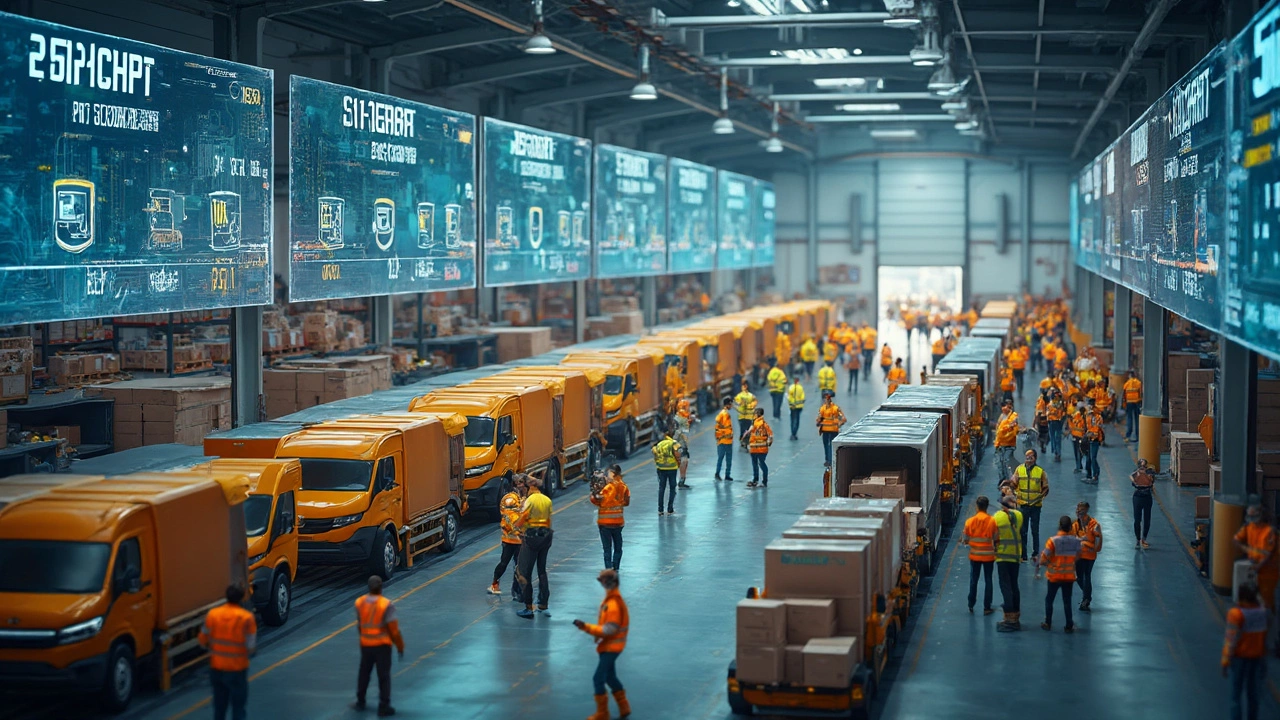Ever stopped to think about how those packages you order online somehow show up at your door, sometimes within a single day? It's not magic—it's logistics software working behind the scenes. This stuff is all about organizing, tracking, and moving goods in the easiest way possible, using computers to do the heavy lifting for people.
Think about the chaos if every delivery, warehouse, and shipping truck ran on sticky notes and guesswork. Logistics software skips the paper mess and tells everyone exactly what's going on in real time. That means you can see where your order is, a company knows how many laptops are left in stock, and drivers get routes that save fuel and time. No more playing phone tag or hunting for lost shipments.
If you run a business or just love learning how the world works, getting a grip on logistics software is practical. It helps companies save money and time, stops stuff from getting lost, and keeps shelves stocked. Plus, it can keep customers (and bosses) happy by making deliveries fast and smooth.
- What is Logistics Software?
- The Core Features and Tools
- How Logistics Software Gets the Job Done
- Tips for Choosing and Using Logistics Software
What is Logistics Software?
Logistics software is the tech backbone that helps businesses plan, manage, and move stuff from point A to point B. It's not just for mega-corporations—local retailers, food delivery companies, and even small manufacturers rely on it to keep their goods flowing smoothly. Think of it like a smart assistant that tracks shipments, updates inventory, figures out delivery routes, and warns you if things go off track.
This kind of software connects every step of the supply chain. For example, when a company gets a new order, the software checks if enough stock is available, picks the fastest (and cheapest) shipping option, and keeps everyone in the loop right up until the delivery is finished. That's a lot of moving parts, so the software needs to be pretty clever.
Here's what most logistics software usually handles:
- Inventory management: Keeping count of every item in warehouses
- Order processing: From the second someone buys something, all the way to shipping
- Fleet and delivery tracking: Real-time maps showing where trucks or packages are
- Warehouse organization: Making sure products are easy to find and pack
- Route optimization: Picking the quickest paths so drivers waste less time and gas
- Communication: Sending updates so nobody is left guessing
Just to show how much this stuff is used, here's a quick snapshot of how popular logistics software really is:
| Year | Estimated Market Value (USD Billions) |
|---|---|
| 2021 | 10.5 |
| 2023 | 13.1 |
| 2025 (projected) | 16.9 |
The reason for all this growth? Speed matters now more than ever. People expect orders yesterday, not next week. So whether you’re running a business or just curious, logistics software is what keeps modern supply chains sane instead of spinning out of control.
The Core Features and Tools
You can’t talk about logistics software without mentioning the tools and features that do all the grunt work. These aren't just nice-to-haves—they’re what make things run smoother and faster, even if you have thousands of shipments moving at once. Here’s what’s usually packed in:
- Inventory management: Probably the most important piece. This tracks what’s coming in, what’s going out, and what’s sitting on the shelf, all in real time. No more running out of stuff or over-ordering by mistake.
- Order tracking: Ever get a tracking link when you buy something online? That’s powered by the backend of logistics software, showing where your package is every step along the trip.
- Route optimization: The system picks the fastest or cheapest route for drivers, sometimes cutting delivery costs by 10-20%. Some software recalculates these routes on the fly if there’s a traffic jam or weather delay.
- Warehouse management: These tools tell staff where to put things, how to find items fast, and help automate stuff like picking, packing, and labeling.
- Reporting and analytics: Spreadsheets are old news. Modern logistics software spits out reports that help you spot delays, check which products are slow sellers, or see how much time is being wasted on certain steps.
- Integration tools: The best logistics software connects with e-commerce sites, CRM platforms, and accounting tools, so you don’t have to do double entry or chase down orders.
Almost every major brand you know—think Amazon or FedEx—leans hard on these features. For example, smarter route planning alone saved UPS more than 100 million miles of driving in one year, just by using software to cut down on left turns and extra trips.
| Feature | Average Time Saved | Potential Cost Savings |
|---|---|---|
| Inventory Management | Up to 85% | Up to 30% less stock-outs |
| Route Optimization | 25% faster deliveries | Up to 20% lower fuel spend |
| Order Tracking | Real-time updates | Higher customer retention |
When picking the right logistics software, look for strong logistics software integration across devices and platforms. Mobile apps for drivers, real-time dashboards for managers, and automation for everything you’re tired of doing by hand—these make all the difference.

How Logistics Software Gets the Job Done
Here’s what really happens under the hood: logistics software pulls in tons of info from all over—like warehouse inventory, delivery schedules, and even traffic updates. It crunches all that data and spits out simple answers, like which order should ship first or the fastest way to get boxes from point A to B. To see it in action, let’s break down its main jobs.
- Tracking Shipments: The software keeps tabs on every item, every truck, every stop. If you’ve ever checked a tracking number online, you’ve seen this in action. Barcodes and sensors send updates at every checkpoint, so everyone knows where stuff is. Amazon, for example, processes over 66,000 orders per hour with smart tracking tools.
- Optimizing Routes: Instead of drivers wasting time stuck in traffic, the software suggests better routes using real-time data. This isn’t just about speed—it saves gas and cuts down on delivery costs big time.
- Managing Stock: Ever been to a store that’s out of the one thing you need? Good logistics software tracks what’s in the warehouse and predicts what will run out soon, so businesses can reorder before shelves go empty.
- Automating Tasks: Manual paperwork is slow and messy. The system updates orders, prints shipping labels, and sends alerts, all without human help. This has been shown to reduce errors by up to 75% in some warehouse settings.
Here are some quick numbers that show just how much logistics software can boost efficiency:
| Benefit | Average Improvement |
|---|---|
| Order Processing Time | Up to 50% faster |
| Stock Accuracy | 99%+ accuracy |
| Delivery Costs | 10-20% lower |
| Error Reduction | Up to 75% fewer mistakes |
Everything ties together through a central dashboard where managers can watch the entire operation in real time. If an order is delayed, they see it right away and can fix the problem. In a nutshell, logistics software turns chaos into order, so both your online shopping and big business supply chains run smoother than ever.
Tips for Choosing and Using Logistics Software
Let’s cut through the overwhelm: picking logistics software doesn’t have to be complicated, but you can’t just pick the first one that pops up on Google. The best fit for you depends on your business size, how much you ship, and how transparent you want your supply chain to be. Get these basics right, and you’ll avoid a lot of hassles down the road.
Here are some pointers to help you pick wisely and actually get value from your software:
- Logistics software with easy dashboard controls and live tracking usually saves people the most headaches. You should be able to see what’s happening at a glance, not after clicking three menus deep.
- Make sure the software can hook up with tools you already use—things like accounting systems, GPS, or your online store. If it needs complicated connectors or a tech wizard every time you want a report, it’s not worth it.
- Cloud-based systems have become the go-to because you don’t have to mess with servers and updates. Plus, you can check in on orders from your phone, whether you’re at your desk or stuck in traffic.
- Look for automation features: stuff like sending customer shipment notifications, updating inventory, or optimizing delivery routes. Automation is a serious time-saver, especially when your orders scale up.
Once you’ve picked your software, don’t skip training. Even the slickest systems flop if your team isn’t comfortable with them. Many sellers offer onboarding to help, and it pays off fast—according to a 2024 study from Gartner, companies that invest a little time in user training see up to a 30% drop in order mistakes.
If you’re on the fence between a couple of tools, sign up for free trials. Try moving a real order through the system from start to finish, and watch for hiccups. See if support responds in a few hours or a few days. The right fit should feel straightforward and let you spend more time on your business—not wrestling with screens.


